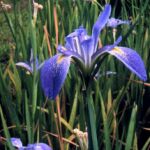| Common Name: |
Blue Flag |
| Other Names: |
Wild Iris |
| Botanical Name: |
Iris versicolor |
| Genus: |
Iris |
| Family: |
Iridaceae |
| Cultivation: |
Well-drained, neutral to alkaline soil in sun (I. germanica var. florentina); rich, moist to wet, acid soil or shallow water in sun (I. versicolor). |
| Propagation: |
By seed sown in autumn or spring; by division or offsets in summer. Cultivars may not come true from seed. |
| Harvest: |
Rhizomes are lifted in the late summer and early autumn, and dried for use in decoctions, liquid extracts, and powders. |
| Native Location: |
Northeastern N America |
| Height: |
50cm-1m (20in-3ft) |
| Width: |
Indefinite |
| Variations: |
Kermesina
Has Plum colored flowers. |
| Hardiness: |
Z3-8 |
| Parts Used: |
Rhizomes |
| Properties: |
An acrid, slightly aromatic, alterative herb that stimulates the liver and gall-bladder, reduces inflammation, increases rates of perspiration and salivation, and acts as a diuretic and laxative. |
| Medicinal Uses: |
Internally for psoriasis, acne, herpes, migraine due to liver dysfunction, arthritis, fibroids, swollen glands, pelvic inflammatory disease, and septicemia. Fresh rhizome causes nausea and diarrhea. Not givento pregnant women. Externally for skin diseases, rheumatism, and infected wounds. Combines well with Phytolacca armericana (See, Indian poke), Rumex crispus (See, curled dock), Stillingia sylvatica (See, queen's delight), or Trifolium pratense (See, red clover), for skin disease. |
| Warning: |
All parts of Iris species, especially rhizomes, are harmful if eaten. Skin irritant and allergen. |
| Bibliography: |
Encyclopedia of Herbs by Deni Brown. Copyright © 1995, 2001 Dorling Kindersley Limited. pg. 244
|

